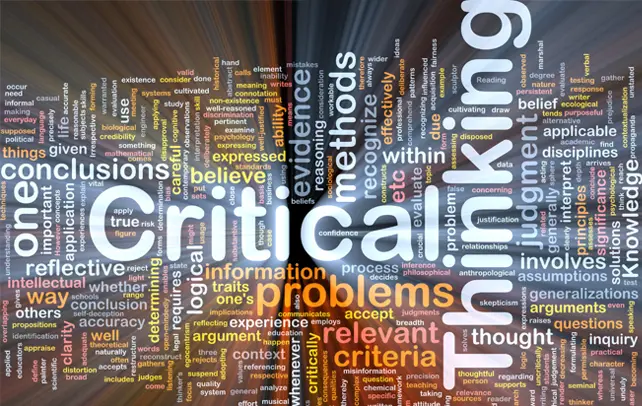What is Critical Thinking?

You are what you think. That's right. Whatever you are doing right now, whatever you feel, whatever you want--all are determined by the quality of your thinking. If your thinking is unrealistic, your thinking will lead to many disappointments. For most people, most of their thinking is subconscious, that is, never explicitly put into words. The problem is that when you are not aware of your thinking you have no chance of “correcting” it. When thinking is subconscious, you are in no position to see any problems in it. And, if you don't see any problems in it, you won't be motivated to change it.
The single most significant variable in determining the quality of what you learn in college is your thinking. Certainly your instructors will play a role in your learning. Some of them will do a better job of helping you learn than others. But even the best instructors can help you very little if you lack the intellectual skills necessary for thinking well through the course content. Our goal is to introduce you to the brain tools you need to reason well through the problems and issues you face, whether in the classroom, in your personal life, or in your professional life. If you take these ideas seriously, you could so something for yourself of lifelong value.
Retrieved from http://www.criticalthinking.org/pages/college-and-university-students/799
Ways to Create Ideas
- Conduct a brainstorm to find solutions, create plans, and discover new ideas. The purpose of brainstorming is to generate as many solutions as possible.
- Focus and let go - alternating parts of the same process. Intense focus taps the resources of your conscious mind, while letting go gives your subconscious mind time to work. When you focus for intense periods and then let go for a while, the conscious and subconscious parts of your brain work in harmony. In doing so, they can produce the highest-quality results. Practice focusing for short periods at first, then give yourself a break.
- Cultivate creative serendipity (the ability to see something valuable that you weren't looking for). You can train yourself in the art of serendipity. First, keep your eyes open. Multiply your contacts with the world, and resolve to meet new people. Read. Go to plays, concerts, art shows, lectures, and movies. And finally, expect discoveries. One recipe for success is being prepared to recognize "luck" when you see it.
- Keep idea files - like 3 x 5 index cards or journal entries - and review them regularly. Something you thought was funny or interesting in November could be the perfect solution to a problem in March.
- Collect and play with data or information. Look from all sides at the data you collect, switching your attention from one aspect to another. Avoid getting stuck on one particular part of a problem, and ask others for input. It has been said that there are no new ideas, only new ways to combine old ideas. Creativity is the ability to discover those new combinations.
- Refine ideas and follow through. Genius resides in the follow-through - the application of perspiration to inspiration. Identify your idea, and then write out what you plan to do about it. Another option is to simplify the idea, mess it up, or deliberately make it more complex. This ties back to playing with information in #5.
- Create success strategies by reading books on success, interviewing successful people, and reflecting and/or changing your current habits that are limiting your success.
- Learn to trust the creative process, even when no answers are in sight. Try not to get impatient and give up altogether, instead recognizing small wins or little aha! moments.
Retrieved from Ellis, D. (2006). Becoming a master student (11th ed.). Boston: Houghton-Mifflin.
C.T. Terms
- Application
- Analysis
- Synthesis
- Evaluation
- Deduction
- Induction
- Adduction
- Refutation
- Extrapolation
- Hypothetical reasoning
- Perspective taking
- Divergent thinking
- Convergent thinking